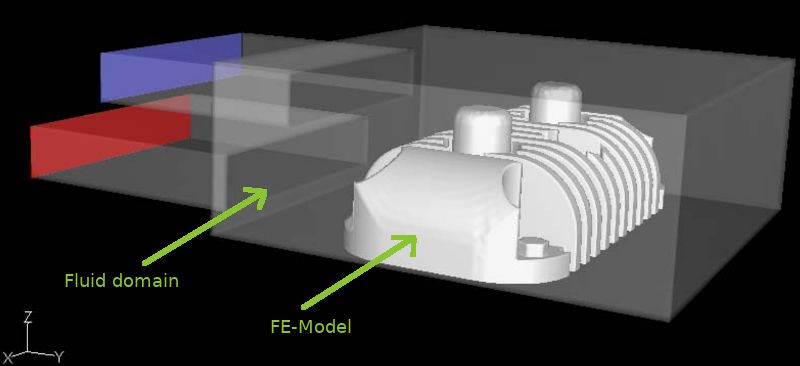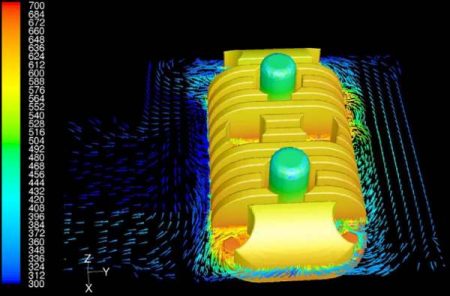The FSI simulation (Fluid-Sstructure-Interaction) describes the interactions between mechanics and flow on the components under consideration. Thereby CFD analysis and FE- Analysis coupled with each other. In this simulation example, the influence of air cooling by heat conduction and heat transfer at the cylinder head on the mechanical stresses, deformations and forces in the component is to be investigated. To carry out the simulation FE- Calculation and CFD Calculation are coupled with each other in such a way that the partial results of the respective time step are available as boundary condition for the FEM calculation as well as for the CFD calculation. Thus, the usability of the results depends on the error-free data transfer at the interface between FEM model and CFD model.
FE- Calculation
For a stable FEM calculation, the model is constructed as cleanly and structured as possible. For the aluminium alloy (EN AW-7075 T6) the following material data are specified:
- Density
- Young's modulus
- Poisson number
- Thermal expansion coefficient
- Specific heat capacity
- Thermal conductivity
Heat capacities and thermal conductivities are considered to be temperature dependent for the aluminium alloy.
Boundary conditions for the FE analysis
The head gasket compensates for the different thermal expansions between the crankcase (grey cast iron) and the head (aluminium). It also compensates for unevenness in the sealing surfaces that occurs over time due to the loads acting on them. Since only the cylinder head is to be considered in the FSI simulation and the gasket is flexible, it is not shown in this case. For simplification, it is therefore assumed that the gasket surface is fixed.
- Bearing: Fixed bearing around the bolt heads and on the sealing surface
- Load: Temperature load on the entire base area
No forces or pressures are defined as initial conditions. Before coupling with the CFD calculation, the FEM calculation is performed and evaluated for result validation.

FSI model of flow chamber and cylinder head
CFD Calculation
For the CFD calculation, the flow space enveloping the cooling fins must be described accordingly, therefore the FEM model is subtracted from the flow space. For the air flowing around the solid at room temperature, the following is assumed for the CFD analysis:
- Viscosity model: k-ε-RNG
- Fluid: Air, as an ideal compressible gas
For the flow around the component, an inflow and an outflow are modelled and a constant mass flow is assumed.
FSI analysis of the component and ambient air
For the FSI simulation, the coupling between flow and structural mechanics must take place at the wall areas in order to map the heat transfer or heat dissipation from the cylinder head walls to the environment. Thus, above all, the numerical exchange of heat flows and wall temperatures is defined for the respective iteration step and some additional settings prevent the simulation from breaking off due to inaccuracies between the FE model and the CFD model.
Result of the FSI analysis
Fluid-structure interaction (FSI simulation) can be used to model stresses and deformations in the component as well as interactions with the ambient air. Due to the complexity of the interaction of CFD calculation and FEM calculation, especially at the interfaces of the models, numerous sources of error arise.

Wall temperature, flow temperature and flow direction
For example, experienced specialists are needed to make the right settings so that an FSI simulation runs stably and delivers plausible results. Despite modern hardware, a complex FSI analysis can quickly lead to enormous computing times, so simplifications are unavoidable in most cases.
We will be happy to explain to you in a personal meeting which simplifications are useful and how you can achieve the desired results. Inform yourself about our range of services !
Further project examples for fluid and structural mechanics simulations: